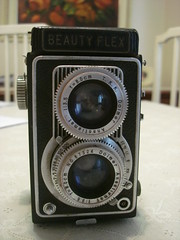Difference between revisions of "Beautyflex"
m (→Links: Corrected Butkus link - the manual is for a Beautyflex S) |
m (One type of system preceded the other.) |
||
| (26 intermediate revisions by 3 users not shown) | |||
| Line 1: | Line 1: | ||
| − | + | {{Japanese postwar 6×6 TLR (A–L)|image=https://live.staticflickr.com/3282/2913040938_f61d344635_m_d.jpg|image2=https://live.staticflickr.com/2654/3897357633_810b1d9c56_m_d.jpg|caption=[https://www.flickr.com/photos/47093120@N00/2913040938/in/pool-camerawiki/ left:] Beautyflex, [https://www.flickr.com/photos/clcosta/3897357633/in/pool-camerawiki/ right:] Beauty Flex<br/><small>l. by {{image_author|Nis Jensen}}, r. by {{image_author|Claudio Costa}}</small> {{with permission}} }} | |
| − | + | <!--{{Flickr_image | |
| + | |image_source= https://www.flickr.com/photos/clcosta/3898140888/in/pool-camerawiki/ | ||
| + | |image= https://live.staticflickr.com/2499/3898140888_8c973ba0d7_m_d.jpg | ||
| + | |image_align= right | ||
| + | |image_text= Beautyflex V | ||
| + | |image_by= Claudio Costa | ||
| + | |image_rights= with permission | ||
| + | }}--> | ||
| + | '''Beauty Flex''' and '''Beautyflex''' are two different series of Japanese 6×6 TLR cameras and made by [[Taiyōdō|Taiyōdō Kōki]]. | ||
| + | |||
| + | Beauty Flex models have front lens cell focusing with a toothed-gear that couples the taking and viewing lenses were made between 1951 and 1953, and were followed by Beautyflex and Beauty models which have lens board movement focusing from 1954. | ||
| + | |||
| + | As was common practise among 1950s Japanese camera manufacturers, a number of the Beautyflex models where rebadged (i.e. made for other sellers with an altered identity) with modest specification changes ([[Fodor]], [[Montgomery Ward]], [[Photoflex]], and [[United States Camera]]) and rebranded (i.e. just given an alternative name for the manufacturer themselves to sell in different markets) as [[Gen]]. | ||
| + | |||
| + | The attribution of rebadges and rebrands can sometimes be tricky, but a good rule of thumb is - if the objective lens is not 80mm, Taiyōdō Kōki did not make it (however, there are two known exceptions - the original Beauty Flex and the Japan only Beauty III). | ||
| − | |||
| − | == Beauty Flex == | + | == Beauty Flex II == |
| − | + | Several versions of the Beauty Flex II are known. The earliest - know through a January 1951 advertisement in Photo Art magazine - features | |
* Geared-lens focus | * Geared-lens focus | ||
* Beauty 75mm f3.5 taking lens | * Beauty 75mm f3.5 taking lens | ||
* Unknown shutter with speeds of 1/15 to 1/150 | * Unknown shutter with speeds of 1/15 to 1/150 | ||
* No accessory shoe or flash sync | * No accessory shoe or flash sync | ||
| + | * Name plate font in outlined letters | ||
| + | * No logo on the viewfinder lid | ||
| + | |||
| + | Another has | ||
| + | * Doimer 80mm f3.5 taking lens | ||
| + | * TKK shutter with speeds of 1 to 1/200 | ||
| + | * Accessory shoe | ||
| + | * Flash sync post on front of body | ||
| + | |||
| + | A variations of the 80mm lens model has | ||
| + | * "T" (for Taiyōdō) logo on the viewfinder lid | ||
| − | == Beauty Flex | + | == Beauty Flex IIA == |
| − | |||
{{Flickr_image | {{Flickr_image | ||
| − | |image_source= | + | |image_source= https://www.flickr.com/photos/127540935@N08/28300938466/in/pool-camerawiki/ |
| − | |image= | + | |image= https://live.staticflickr.com/8878/28300938466_d4421e0343_m_d.jpg |
|image_align= right | |image_align= right | ||
| − | |image_text= | + | |image_text= Beauty Flex IV<br/>(early version, if not maybe a Beauty Flex III)<ref>Although references to a '''Beauty Flex III''' may be found elsewhere on the Internet, there is no evidence supporting the existence of this model. Type numbers given to all versions identified in this text are supported by documents; names on packaging boxes, instruction manuals and other literature produced by Taiyōdō Kōki, plus magazine advertisements (which for technical reasons cannot be reproduced here). There is no known box, document, or advertisement for a model III. In addition, the "evolution" of types II to the early IV is largely attributable to the viewfinder cover front name badge changing from flat metal to one with a fluted edge and raised lettering, plus the flash sync "post" becoming a more modern "socket" along with its relocation from the front to the user's left side of the body due the lack of space for the bigger socket to remain on the front of the camera. To spell this out, the IIA had a raised lettering name plate and a front of body sync "post". The early IV added the side of body flash "socket". This suggests there was no logical intermediate configurations for a model III. A single know example of a camera with a raised lettering name plate and front of body flash "socket" was sold on Etsy, but it had a clumsy appearance: the edges of that socket were crimped to allow a fit, and it looked like an after-market modification? It may be logical to expect a model III, just as one might expect a model I (or a no-number type), but there are many other examples of manufactures not adhering to logical numbering schemes.</ref> |
| − | |image_by= | + | |image_by= Chasing Classic Cameras with Chris |
| − | |image_rights= | + | |image_rights= wp |
}} | }} | ||
| − | + | This was like an 80mm lens type II but for - | |
| − | + | * Name plate changed from flat plate to one with fluted edges and raised solid lettering. | |
| − | |||
| − | |||
| − | |||
| − | |||
| − | |||
| − | * Name plate | ||
| − | |||
| − | |||
| − | |||
| − | |||
| − | |||
== Beauty Flex IV (early & late versions) == | == Beauty Flex IV (early & late versions) == | ||
| − | + | Thought to date to about 1952, the type IV number is known through advertising material and user manuals. There were two models and both had | |
| − | * Name plate changed from flat plate to one with fluted edges and solid lettering | + | * Name plate changed from flat plate to one with fluted edges and solid lettering. |
| − | * '''Early version''' | + | * A side of body flash sync socket. |
| − | * '''Late version''' - | + | There were two versions. |
| + | * '''Early version''' (as described above). | ||
| + | * '''Late version''' - has a fluted decorative plate surrounding the viewing lenses, but is otherwise the same as the "early version". | ||
| + | {{Flickr_image | ||
| + | |image_source= https://www.flickr.com/photos/80936052@N00/53736112339/in/pool-camerawiki | ||
| + | |image= https://live.staticflickr.com/65535/53736112339_21316290bb_z_d.jpg | ||
| + | |image_align= right | ||
| + | |image_text= Beautyflex V | ||
| + | |image_by= Kirk Thorsteinson | ||
| + | |image_rights= with permission | ||
| + | }} | ||
== Beauty Flex V == | == Beauty Flex V == | ||
* Thought to date to about 1953 | * Thought to date to about 1953 | ||
| Line 50: | Line 72: | ||
* 4. Modified catch for the back | * 4. Modified catch for the back | ||
* The Beautyflex V was rebranded as the (early) CSL '''[[Photoflex]]''' | * The Beautyflex V was rebranded as the (early) CSL '''[[Photoflex]]''' | ||
| + | {{brr}} | ||
== Beautyflex S/Beauty S == | == Beautyflex S/Beauty S == | ||
| Line 67: | Line 90: | ||
* There is a variant which has a "Beauty" name badge rather than "Beautyflex", and this was only sold in Japan. | * There is a variant which has a "Beauty" name badge rather than "Beautyflex", and this was only sold in Japan. | ||
| − | == Beauty III == | + | == Beauty III S == |
| − | * There was a further Japan only Beauty S variant called the "Beauty III", which had unusual 75mm f/3.1 lenses. | + | * There was a further Japan only Beauty S variant called the "Beauty III S", which had unusual 75mm f/3.1 lenses. This model is marked "Beauty III" on the nameplate and "S" on the viewfinder lid. |
== Beautyflex T == | == Beautyflex T == | ||
| Line 83: | Line 106: | ||
{{Flickr_image | {{Flickr_image | ||
|image_source= https://www.flickr.com/photos/gomjabbar76/46920649482/in/pool-camerawiki/ | |image_source= https://www.flickr.com/photos/gomjabbar76/46920649482/in/pool-camerawiki/ | ||
| − | |image= http://farm5.staticflickr.com/4895/ | + | |image= http://farm5.staticflickr.com/4895/46920649482_f1e068bfbc_w.jpg |
|image_align= left | |image_align= left | ||
| − | |image_text= Beautyflex D | + | |image_text= Beautyflex D Synchro-MX model |
|image_by= Sebastian Freitag | |image_by= Sebastian Freitag | ||
|image_rights= wp | |image_rights= wp | ||
| Line 94: | Line 117: | ||
* 1. Biokor 3.5/80 mm lens in a Synchro-MX 1 - 1/300 shutter | * 1. Biokor 3.5/80 mm lens in a Synchro-MX 1 - 1/300 shutter | ||
* The Biokor/Synchro-MX variant was rebadged as the '''[[Wardflex_(metal)|Wardflex II]]''' and the '''[[USC Auto Fifty]]''', and also rebranded by TKK as the (late) CSL '''[[Photoflex]]''' | * The Biokor/Synchro-MX variant was rebadged as the '''[[Wardflex_(metal)|Wardflex II]]''' and the '''[[USC Auto Fifty]]''', and also rebranded by TKK as the (late) CSL '''[[Photoflex]]''' | ||
| + | {{Flickr_image | ||
| + | |image_source= https://www.flickr.com/photos/80936052@N00/53735958749/in/pool-camerawiki/ | ||
| + | |image= https://live.staticflickr.com/65535/53735958749_09d34c4b6c_n_d.jpg | ||
| + | |image_align= right | ||
| + | |image_text= illustration, c. 1957: [[Wardflex II]]<br/> | ||
| + | |scan_by= Kirk Thorsteinson | ||
| + | |image_rights= with permission | ||
| + | }} | ||
* 2. Biokor 3.5/80 mm lens in a Synchro-MXV 1 - 1/300 shutter | * 2. Biokor 3.5/80 mm lens in a Synchro-MXV 1 - 1/300 shutter | ||
* The Biokor/Synchro-MXV variant was rebadged as the '''[[Fodorflex]]''' | * The Biokor/Synchro-MXV variant was rebadged as the '''[[Fodorflex]]''' | ||
* 3. Biokor 3.5/80 lens in a Rectus 1 - 1/300 shutter | * 3. Biokor 3.5/80 lens in a Rectus 1 - 1/300 shutter | ||
* 4. Biokor 3.5/80 mm lens in a [[Copal]]-MX 1 - 300 shutter | * 4. Biokor 3.5/80 mm lens in a [[Copal]]-MX 1 - 300 shutter | ||
| + | {{Flickr_image | ||
| + | |image_source= https://www.flickr.com/photos/29504544@N08/9756228644/in/ppool-camerawiki | ||
| + | |image= https://live.staticflickr.com/3797/9756228644_406e7b5dce_m.jpg | ||
| + | |image_align= right | ||
| + | |image_text= [[Copal-MX]] leaf shutter | ||
| + | |image_by= Hans Kerensky | ||
| + | |image_rights= with permission | ||
| + | }} | ||
| + | {{br}} | ||
| + | |||
| + | == Beautyflex K == | ||
| + | This model was a variant of the 28 with f/3.5 lenses and a few aesthetic differences. | ||
| − | + | == Beautyflex U == | |
| + | This model was another variant of the 28 with alternative lenses/shutters, but the most distinguishing feature was the shutter release and flash sync positions were swapped, so it was effectively a left-hand layout. | ||
== Beautyflex 28 == | == Beautyflex 28 == | ||
| Line 131: | Line 175: | ||
== Bibliography == | == Bibliography == | ||
| − | * Advertisement for the Beauty Flex II in the January 1951 issue of Photo Art (フォトアート) reproduced on [https://www.flickr.com/photos/camerawiki/49267656781/in/photolist-2i4BBUi-2gemREb-2gdQVcL-2gdRrXz-7xkGNa-Tk2a4y-bmzVLM-2o5UDnr-Tk2a1s-2geSv5c-Tcearg-x4uHyL-2nuQq75-2geT6an-2o5VyiY-2o3jxVy-2o5UDnX-S7aiej-2i3MsE2-2i3MyU1-2o3icYT-2eLJEBC-2geSZHq-TceamX-2i3K1t5-2o3jxRL-2nuRE8F-2nuPaJD-2o5VyjQ-2o3jxTu-Tk2a7j-2gdjjkX-Tk2aaf-2o5QS2f-2o5QS2a-2o5TdeQ-2o5QRZG-2o5QRXT-2o3gLLc-2o3id8F-2o3jxQy-2geSPNG-H2N8Z4-2o3jxZg-2o3icZK-2o3ene7-2o3id2Z-2gdjTjD-2nLKFPP-2iDLriB Flickr] | + | * Advertisement for the Beauty Flex II in the January 1951 issue of Photo Art (フォトアート) reproduced on [https://www.flickr.com/photos/camerawiki/49267656781/in/photolist-2i4BBUi-2gemREb-2gdQVcL-2gdRrXz-7xkGNa-Tk2a4y-bmzVLM-2o5UDnr-Tk2a1s-2geSv5c-Tcearg-x4uHyL-2nuQq75-2geT6an-2o5VyiY-2o3jxVy-2o5UDnX-S7aiej-2i3MsE2-2i3MyU1-2o3icYT-2eLJEBC-2geSZHq-TceamX-2i3K1t5-2o3jxRL-2nuRE8F-2nuPaJD-2o5VyjQ-2o3jxTu-Tk2a7j-2gdjjkX-Tk2aaf-2o5QS2f-2o5QS2a-2o5TdeQ-2o5QRZG-2o5QRXT-2o3gLLc-2o3id8F-2o3jxQy-2geSPNG-H2N8Z4-2o3jxZg-2o3icZK-2o3ene7-2o3id2Z-2gdjTjD-2nLKFPP-2iDLriB Flickr]. This is for the model with 75mm lenses. |
* ''Watakushi no ni-gan-refu kamera-ten'' (私の二眼レフカメラ展, Exhibition of twin lens reflex cameras). Tokyo: JCII Camera Museum, 1992. (Exhibition catalogue, no ISBN number.) P. 26. | * ''Watakushi no ni-gan-refu kamera-ten'' (私の二眼レフカメラ展, Exhibition of twin lens reflex cameras). Tokyo: JCII Camera Museum, 1992. (Exhibition catalogue, no ISBN number.) P. 26. | ||
| Line 147: | Line 191: | ||
}} | }} | ||
In Japanese: | In Japanese: | ||
| − | * [https://www.dujingtou.com/article_625.shtml Taiyodo Koki TLRs] at [https://www.dujingtou.com/ Dujingtou.com] | + | * [https://www.dujingtou.com/article_625.shtml Taiyodo Koki TLRs] at [https://www.dujingtou.com/ Dujingtou.com] (Essentially a copy of Barry Togoods TLR Cameras Website) |
* [https://www.awane-camera.com/1/4/beauty_beautyflex-4/index.htm Beautyflex IV] at [https://www.awane-camera.com/1/4/index.htm Awane-Photo's camera museum] | * [https://www.awane-camera.com/1/4/beauty_beautyflex-4/index.htm Beautyflex IV] at [https://www.awane-camera.com/1/4/index.htm Awane-Photo's camera museum] | ||
| − | * [http://archive.is/www.geocities.jp/yastsuji/beauty-v.html Beautyflex V] at [http://archive.is/www.geocities.jp/yastsuji/ Otowa no nigan-refu] (archived) | + | <!-- * [http://archive.is/www.geocities.jp/yastsuji/beauty-v.html Beautyflex V] at [http://archive.is/www.geocities.jp/yastsuji/ Otowa no nigan-refu] (archived) I have commented-out this low value link --> |
* [https://www.awane-camera.com/1/4/beauty_beautyflex-t/index.htm Beautyflex T] at [https://www.awane-camera.com/1/4/index.htm Awane-Photo's camera museum] | * [https://www.awane-camera.com/1/4/beauty_beautyflex-t/index.htm Beautyflex T] at [https://www.awane-camera.com/1/4/index.htm Awane-Photo's camera museum] | ||
| − | * [http://archive.is/www.geocities.jp/yastsuji/beauty.html Beautyflex T] at [http://archive.is/www.geocities.jp/yastsuji/ Otowa no nigan-refu] (archived) | + | <!-- * [http://archive.is/www.geocities.jp/yastsuji/beauty.html Beautyflex T] at [http://archive.is/www.geocities.jp/yastsuji/ Otowa no nigan-refu] (archived) As above, I have commented-out this low value link --> |
| − | |||
In English; | In English; | ||
| − | * [ | + | *[https://web.archive.org/web/20171201043239/westfordcomp.com/classics/beautyflex/index.htm Beautyflex] on [https://web.archive.org/web/20171102143419/http://www.westfordcomp.com/ Westfordcomp.com] (archived) |
* [http://www.tlr-cameras.com/Japanese/Taiyodo.html Study on Taiyodo Koki TLR's] on [http://www.tlr-cameras.com/index.htm Barry Togoods TLR Cameras Website] | * [http://www.tlr-cameras.com/Japanese/Taiyodo.html Study on Taiyodo Koki TLR's] on [http://www.tlr-cameras.com/index.htm Barry Togoods TLR Cameras Website] | ||
| − | * [https://www.butkus.org/chinon/beauty/beauty_cameras.htm Beautyflex Models S and D] instruction manuals in PDF format (English) from [http://www.butkus.org/chinon/ OrphanCameras.com website] | + | * [https://www.butkus.org/chinon/beauty/beauty_cameras.htm Beautyflex Models S and D] plus [https://www.butkus.org/chinon/wardflex/wardflex/wardflex.htm Wardflex] (Beautyflex Model T) instruction manuals in PDF format (English) from [http://www.butkus.org/chinon/ OrphanCameras.com website] |
| − | * A | + | * A comprehensive illustrated guide to [https://heyjohnbear.wixsite.com/taiyodo/beauty-flexes Beauty Flex] and [https://heyjohnbear.wixsite.com/taiyodo/beautyflexes Beautyflex] cameras at [https://heyjohnbear.wixsite.com/taiyodo Taiyodo Koki & the Beauty Camera Company] |
{{br}} | {{br}} | ||
| − | |||
| − | |||
| − | |||
| − | |||
| − | |||
| − | |||
| − | |||
| − | |||
[[Category: Japanese 6x6 TLR]] | [[Category: Japanese 6x6 TLR]] | ||
| Line 173: | Line 208: | ||
[[Category: B]] | [[Category: B]] | ||
[[Category:Image by MC JC]] | [[Category:Image by MC JC]] | ||
| + | [[Category:120 film]] | ||
Latest revision as of 11:26, 22 May 2024
Beauty Flex and Beautyflex are two different series of Japanese 6×6 TLR cameras and made by Taiyōdō Kōki.
Beauty Flex models have front lens cell focusing with a toothed-gear that couples the taking and viewing lenses were made between 1951 and 1953, and were followed by Beautyflex and Beauty models which have lens board movement focusing from 1954.
As was common practise among 1950s Japanese camera manufacturers, a number of the Beautyflex models where rebadged (i.e. made for other sellers with an altered identity) with modest specification changes (Fodor, Montgomery Ward, Photoflex, and United States Camera) and rebranded (i.e. just given an alternative name for the manufacturer themselves to sell in different markets) as Gen.
The attribution of rebadges and rebrands can sometimes be tricky, but a good rule of thumb is - if the objective lens is not 80mm, Taiyōdō Kōki did not make it (however, there are two known exceptions - the original Beauty Flex and the Japan only Beauty III).
Contents
Beauty Flex II
Several versions of the Beauty Flex II are known. The earliest - know through a January 1951 advertisement in Photo Art magazine - features
- Geared-lens focus
- Beauty 75mm f3.5 taking lens
- Unknown shutter with speeds of 1/15 to 1/150
- No accessory shoe or flash sync
- Name plate font in outlined letters
- No logo on the viewfinder lid
Another has
- Doimer 80mm f3.5 taking lens
- TKK shutter with speeds of 1 to 1/200
- Accessory shoe
- Flash sync post on front of body
A variations of the 80mm lens model has
- "T" (for Taiyōdō) logo on the viewfinder lid
Beauty Flex IIA

|
| Beauty Flex IV (early version, if not maybe a Beauty Flex III)[1] image by Chasing Classic Cameras with Chris (Image rights) |
This was like an 80mm lens type II but for -
- Name plate changed from flat plate to one with fluted edges and raised solid lettering.
Beauty Flex IV (early & late versions)
Thought to date to about 1952, the type IV number is known through advertising material and user manuals. There were two models and both had
- Name plate changed from flat plate to one with fluted edges and solid lettering.
- A side of body flash sync socket.
There were two versions.
- Early version (as described above).
- Late version - has a fluted decorative plate surrounding the viewing lenses, but is otherwise the same as the "early version".

|
| Beautyflex V image by Kirk Thorsteinson (Image rights) |
Beauty Flex V
- Thought to date to about 1953
- Closely resembles the later model IV with key differences
- 1. Rounded triangle TKK logo on the viewfinder lid
- 2. Etoal 1/10 to 1/200 shutter with front-mounted release
- 3. Synch plug socket bottom right
- 4. Modified catch for the back
- The Beautyflex V was rebranded as the (early) CSL Photoflex
Beautyflex S/Beauty S
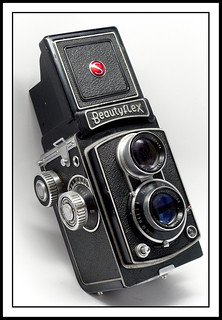
|
| Beautyflex S image by MC JC (Image rights) |
- This model introduced the transition from gear coupled taking and viewing lenses to lens board movement focusing
- Thought to date to about 1954.
- Lens: Beauty 80mm f3.5
- Shutter: NKS-FB MX 1 to 1/300
- Neither the S or the T featured the rounded triangle TKK logo on the viewfinder lid, as introduced in the V and carried forward to the D.
- There is a variant which has a "Beauty" name badge rather than "Beautyflex", and this was only sold in Japan.
Beauty III S
- There was a further Japan only Beauty S variant called the "Beauty III S", which had unusual 75mm f/3.1 lenses. This model is marked "Beauty III" on the nameplate and "S" on the viewfinder lid.
Beautyflex T
- Also thought to date to about 1954
- Looks similar to the S except that there is no decorative connecting block between the two lenses
- Lens: FC Telmer 80mm f3.5
- Shutter: TKK MX 1 to 1/300
- The Beautyflex T was rebadged as the Wardflex I, which was in turn rebranded by TKK as the Gen-flex (i.e. the Gen-flex is a copy of the Wardflex I rather than a copy of the Beautyflex T)
Beautyflex D
|
- Thought to date to about 1955
- Several Known Lens/Shutter combinations:
- 1. Biokor 3.5/80 mm lens in a Synchro-MX 1 - 1/300 shutter
- The Biokor/Synchro-MX variant was rebadged as the Wardflex II and the USC Auto Fifty, and also rebranded by TKK as the (late) CSL Photoflex

|
| illustration, c. 1957: Wardflex II scanned by Kirk Thorsteinson (Image rights) |
- 2. Biokor 3.5/80 mm lens in a Synchro-MXV 1 - 1/300 shutter
- The Biokor/Synchro-MXV variant was rebadged as the Fodorflex
- 3. Biokor 3.5/80 lens in a Rectus 1 - 1/300 shutter
- 4. Biokor 3.5/80 mm lens in a Copal-MX 1 - 300 shutter

|
| Copal-MX leaf shutter image by Hans Kerensky (Image rights) |
Beautyflex K
This model was a variant of the 28 with f/3.5 lenses and a few aesthetic differences.
Beautyflex U
This model was another variant of the 28 with alternative lenses/shutters, but the most distinguishing feature was the shutter release and flash sync positions were swapped, so it was effectively a left-hand layout.
Beautyflex 28
- Whilst commonly referred to as the 2.8, early Taiyōdō brochures identify the camera as the Beautyflex Model 28.
- This is an uncommon model, and among only a very few TLRs to have f/2.8 lenses (the best known being Rolleiflex models).
- There are three variants, which differ by their Rolleiflex compatible Bay filter fittings
- 1. No bayonet
- 2. Single Bay III mounting on the taking lens
- 3. Double Bay III mounting on both lenses
- All three variants share the same lenses and shutter
- Lens - Cantor 80mm f2.8
- Shutter - Copal 1 to 1/200
 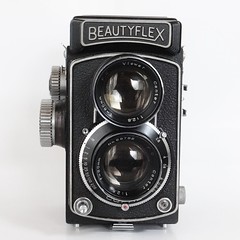 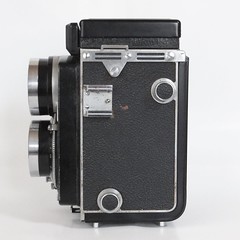
|
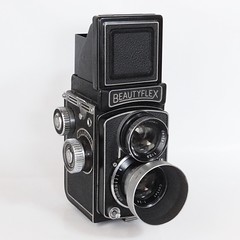 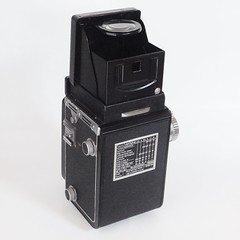 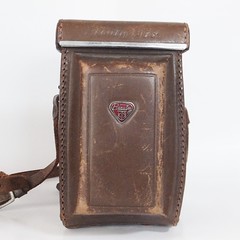
|
| Taiyōdō Kōki Beautyflex Model 28 without filter bayonets Images by yalluflex. (Image rights) |
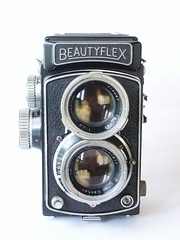 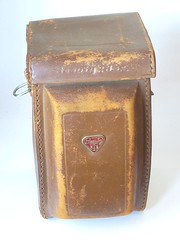 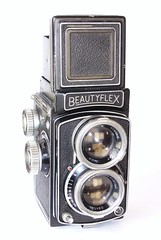
|
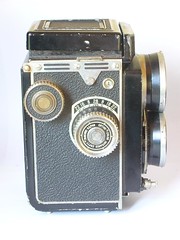 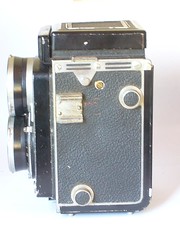 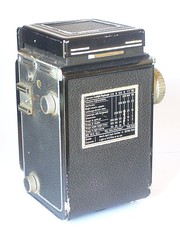
|
| Taiyōdō Kōki Beautyflex Model 28 with filter bayonets on both lenses Images by yalluflex. (Image rights) |
Bibliography
- Advertisement for the Beauty Flex II in the January 1951 issue of Photo Art (フォトアート) reproduced on Flickr. This is for the model with 75mm lenses.
- Watakushi no ni-gan-refu kamera-ten (私の二眼レフカメラ展, Exhibition of twin lens reflex cameras). Tokyo: JCII Camera Museum, 1992. (Exhibition catalogue, no ISBN number.) P. 26.
Notes
- ↑ Although references to a Beauty Flex III may be found elsewhere on the Internet, there is no evidence supporting the existence of this model. Type numbers given to all versions identified in this text are supported by documents; names on packaging boxes, instruction manuals and other literature produced by Taiyōdō Kōki, plus magazine advertisements (which for technical reasons cannot be reproduced here). There is no known box, document, or advertisement for a model III. In addition, the "evolution" of types II to the early IV is largely attributable to the viewfinder cover front name badge changing from flat metal to one with a fluted edge and raised lettering, plus the flash sync "post" becoming a more modern "socket" along with its relocation from the front to the user's left side of the body due the lack of space for the bigger socket to remain on the front of the camera. To spell this out, the IIA had a raised lettering name plate and a front of body sync "post". The early IV added the side of body flash "socket". This suggests there was no logical intermediate configurations for a model III. A single know example of a camera with a raised lettering name plate and front of body flash "socket" was sold on Etsy, but it had a clumsy appearance: the edges of that socket were crimped to allow a fit, and it looked like an after-market modification? It may be logical to expect a model III, just as one might expect a model I (or a no-number type), but there are many other examples of manufactures not adhering to logical numbering schemes.
Links

|
| Comparison with a better-known Japanese TLR image by kavandje (Image rights) |
In Japanese:
- Taiyodo Koki TLRs at Dujingtou.com (Essentially a copy of Barry Togoods TLR Cameras Website)
- Beautyflex IV at Awane-Photo's camera museum
- Beautyflex T at Awane-Photo's camera museum
In English;
- Beautyflex on Westfordcomp.com (archived)
- Study on Taiyodo Koki TLR's on Barry Togoods TLR Cameras Website
- Beautyflex Models S and D plus Wardflex (Beautyflex Model T) instruction manuals in PDF format (English) from OrphanCameras.com website
- A comprehensive illustrated guide to Beauty Flex and Beautyflex cameras at Taiyodo Koki & the Beauty Camera Company

